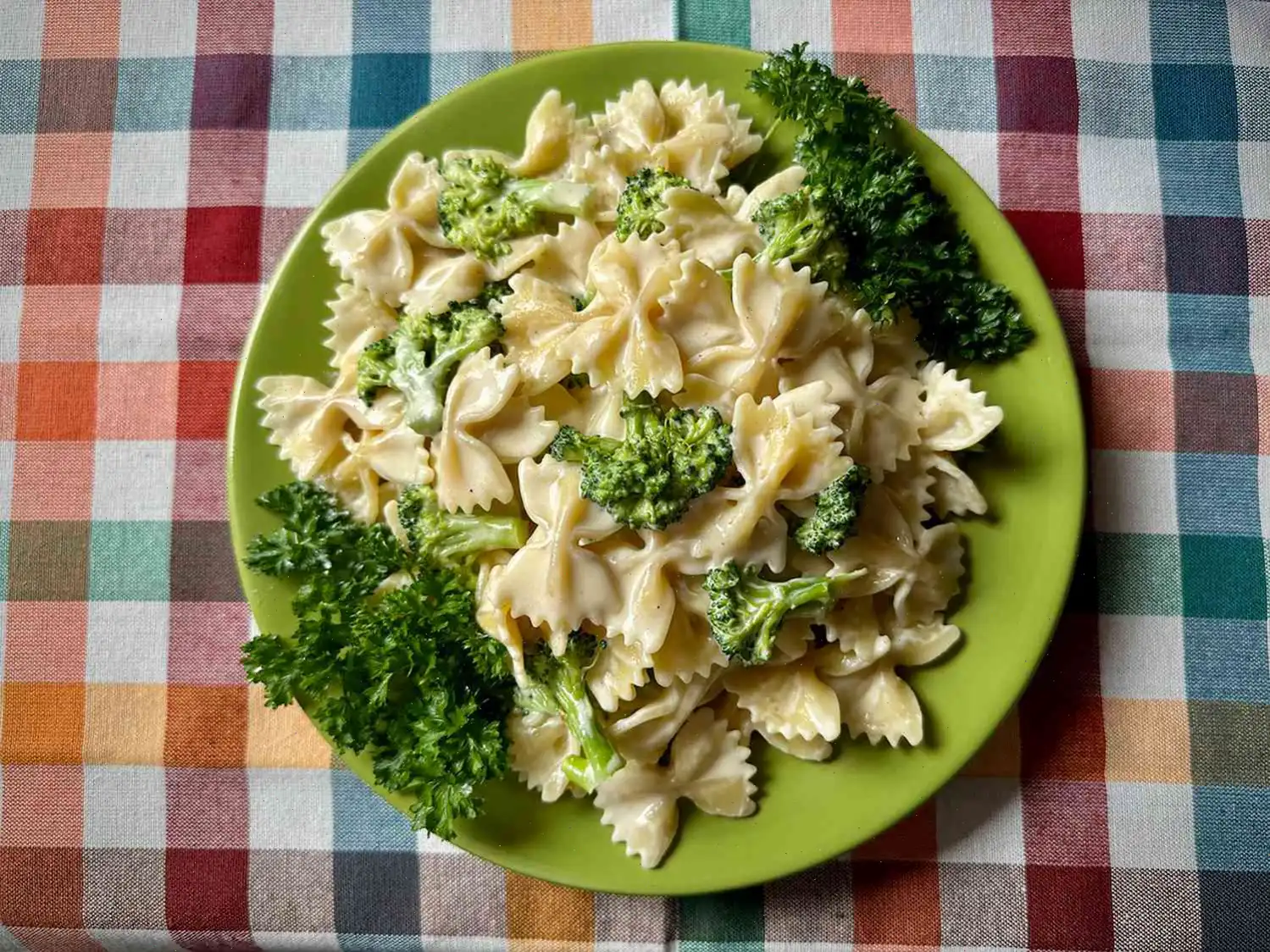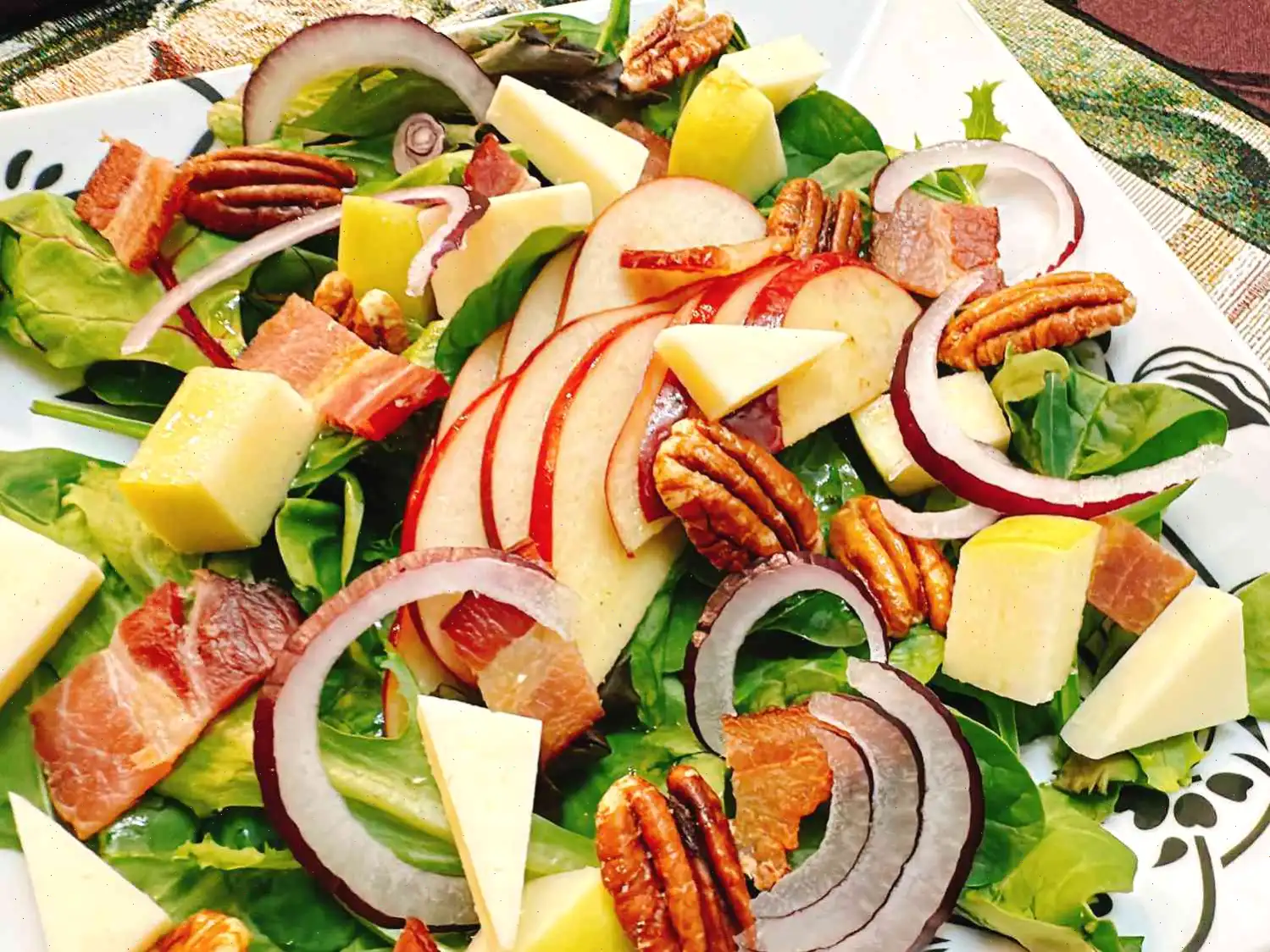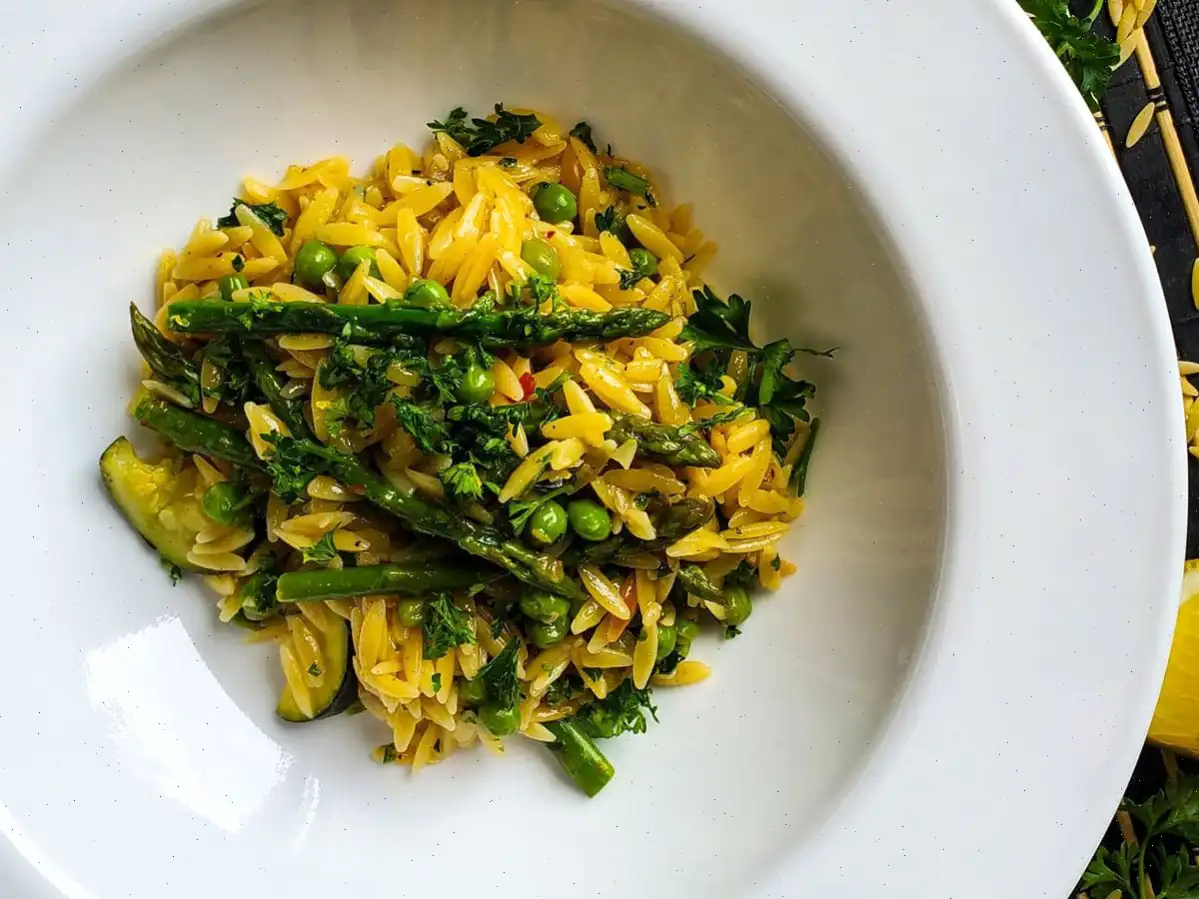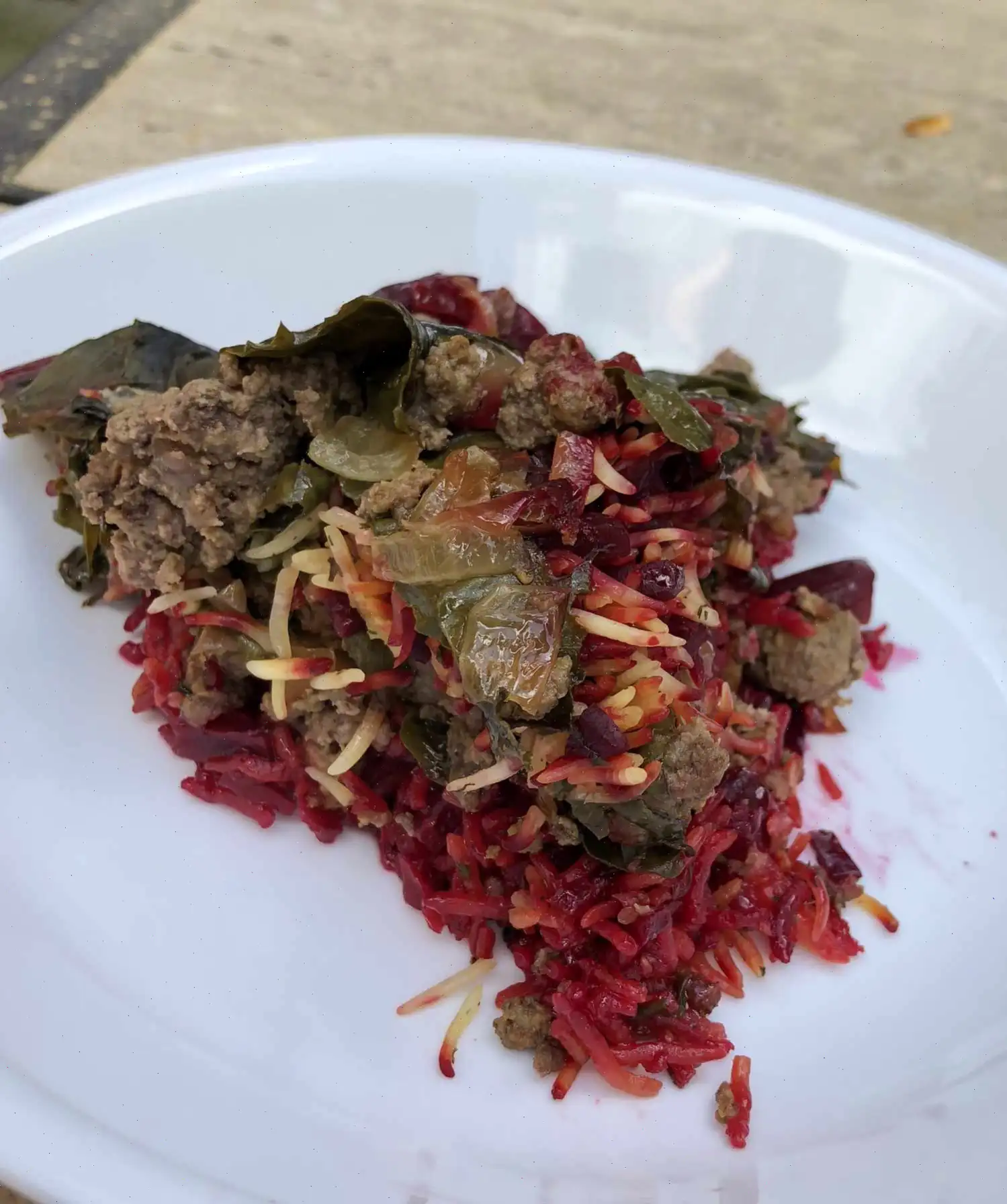
Broccoli Alfredo Pasta Recipe
Ingredients
This recipe is designed for 2 servings. Quantities adjust automatically, but cooking steps remain the same.
- 4 ounces farfalle pasta
- 2 cups fresh broccoli florets
- 2 tablespoons unsalted butter
- 1/2 cup heavy cream
- 3/4 cup freshly grated Parmesan cheese
- 1/2 teaspoon minced garlic
- 1 pinch ground nutmeg, to taste
- Salt and freshly ground black pepper, to taste
- Fresh parsley sprigs for garnish (optional)
Directions
- Bring a large pot of lightly salted water to a boil. Cook the farfalle pasta until al dente, about 12 minutes, stirring occasionally. Drain and reserve some pasta water for later.
- Place the broccoli in a microwave-safe bowl with 1/4 cup of water. Cover and microwave on high until bright green and tender-crisp, about 4 minutes. Drain and season lightly with salt. Keep warm.
- In a skillet over low heat, melt the butter. Add the heavy cream and simmer gently, stirring often, for 3-4 minutes.
- Stir in the Parmesan cheese and garlic, mixing continuously until the cheese melts into a smooth sauce. Add nutmeg and remove from heat. If the sauce is too thick, loosen it with a splash of reserved pasta water. Season with salt and pepper to taste.
- Combine the cooked pasta, broccoli, and sauce in a large serving bowl. Toss gently to coat. Garnish with fresh parsley sprigs if desired.
Cooks Tip: 4 minutes is ideal for broccoli that is tender yet crisp. For softer broccoli, add 1-2 more minutes. Freshly grated Parmesan ensures a creamy sauce; pre-grated cheese may contain anti-caking agents that prevent smooth melting.
Nutrition Facts (per serving)
- Calories: 608
- Total Fat: 45g (57% DV)
- Saturated Fat: 27g (134% DV)
- Cholesterol: 130mg (43% DV)
- Sodium: 906mg (39% DV)
- Total Carbohydrates: 36g (13% DV)
- Dietary Fiber: 6g (22% DV)
- Total Sugars: 4g
- Protein: 20g (39% DV)
- Vitamin C: 102mg (113% DV)
- Calcium: 431mg (33% DV)
- Iron: 2mg (11% DV)
- Potassium: 614mg (13% DV)
*Percent Daily Values are based on a 2,000 calorie diet. Nutrient amounts may vary depending on ingredient brands and preparation.
The History and Cultural Significance of Broccoli Alfredo Pasta
Broccoli Alfredo Pasta, a creamy and comforting dish, has its roots in Italian-American cuisine. While traditional Alfredo sauce originated in Rome in the early 20th century, made with butter, cream, and Parmesan cheese, the addition of vegetables like broccoli reflects an American adaptation. The dish gained popularity in the United States during the mid-20th century, as Italian immigrants combined classic techniques with locally available ingredients to create rich, satisfying meals suitable for family dining.
Regional Variations
Although the base of Broccoli Alfredo Pasta remains consistent, regional differences exist. In the United States, some versions include chicken, bacon, or peas, enhancing protein content and adding depth of flavor. In contrast, Italian versions tend to focus on simplicity and quality of ingredients, using freshly grated Parmesan, high-quality butter, and seasonal vegetables. The choice of pasta shape also varies: farfalle is common in American adaptations for its ability to hold sauce, while in Italy, fettuccine or penne may be preferred.
Differences from Similar Dishes
Broccoli Alfredo Pasta is often compared to other creamy pasta dishes such as Carbonara or Cacio e Pepe. Unlike Carbonara, which relies on eggs and cured pork, Broccoli Alfredo is purely cream-based. Unlike Cacio e Pepe, which is minimalistic and pepper-forward, Alfredo emphasizes richness and smooth texture. The presence of broccoli not only adds a vibrant color but also a subtle crunch and nutritional boost, distinguishing it from heavier, meat-centric variations.
Typical Serving Contexts
This pasta dish is versatile, suitable for both casual family dinners and restaurant menus. It is often served as a main course in Italian-American restaurants, accompanied by garlic bread or a light salad. Its creamy sauce makes it a comforting option for colder months, while the bright green broccoli provides visual appeal and a fresh contrast to the rich cream. Many home cooks also enjoy it as a quick weeknight meal, as it can be prepared in under 30 minutes without sacrificing flavor.
Interesting Facts
Despite its American popularity, Alfredo sauce is relatively unknown in traditional Italian cooking, where pasta dishes are generally lighter. The name Alfredo comes from Alfredo di Lelio, a Roman restaurateur who first created the creamy sauce for his wife in the early 1900s. Broccolis inclusion is entirely an American innovation, reflecting the country's love for combining vegetables with indulgent sauces. Additionally, pairing broccoli with Parmesan creates a naturally savory balance that reduces the need for excessive seasoning, making the dish both flavorful and visually appealing.
FAQ about Broccoli Alfredo Pasta Recipe
Comments
LushRice6911
10/06/2025 01:52:54 PM
it was very good. I added a little chicken and sprinkled a little red pepper flakes on top.
Samantha Smith
08/17/2024 08:52:57 PM
So quick, so good! 🙌
SharonElise
07/23/2024 10:03:36 PM
Fast early and yummy. I added bacon and peas instead of broccoli. Thank you for this recipe!
Deborah Johnson
06/10/2024 11:25:56 PM
Such a WIN! 🙌
OrangeBowl4614
05/06/2024 08:52:50 PM
It was delicious








